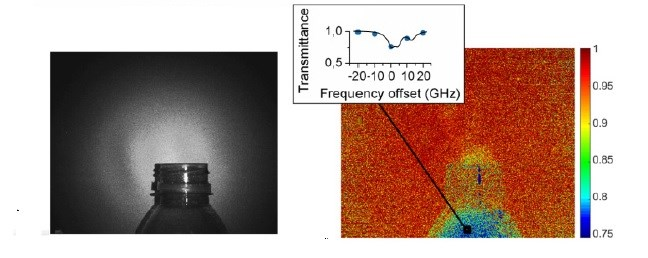Feb 28 2020
A sophisticated analytical method, called dual-comb spectroscopy, has now been used by scientists, for the first time, to rapidly obtain highly detailed hyperspectral images.
 The researchers used their new direct hyperspectral dual-comb imaging approach to acquire hyperspectral images of ammonia gas escaping from a bottle. The left image shows a photograph of the scene while the right image shows a map of ammonia transmittance extracted from a single interferogram. The inset shows the spectral response measured by the system at a particular pixel. Image Credit: Pedro Martín-Mateos, Universidad Carlos III de Madrid.
The researchers used their new direct hyperspectral dual-comb imaging approach to acquire hyperspectral images of ammonia gas escaping from a bottle. The left image shows a photograph of the scene while the right image shows a map of ammonia transmittance extracted from a single interferogram. The inset shows the spectral response measured by the system at a particular pixel. Image Credit: Pedro Martín-Mateos, Universidad Carlos III de Madrid.
The latest technique acquires a complete spectrum of data for every pixel in a scene with excellent speed and sensitivity. Therefore, this method could significantly advance a variety of industrial and scientific applications like biomedical sensing and chemical analysis.
Dual-comb spectroscopy has revolutionized optical spectroscopy by providing unmatched spectral resolution and accuracy as well as short acquisition times without moving parts. Our new direct hyperspectral dual-comb imaging approach will make it possible to expand most of the point-detection capabilities of current dual-comb systems to create a spectral image of an entire scene.
Pedro Martín-Mateos, Research Team Leader, Universidad Carlos III de Madrid
Two optical sources, called optical frequency combs, are used by dual-comb spectroscopy. These sources discharge a spectrum of frequencies—or colors—that are optimally spaced just like how the teeth are spaced on a comb.
This is the first-ever study where a video camera has been used to directly identify a dual-comb spectrum. It has been reported in Optica, The Optical Society’s journal intended for high-impact research.
“We demonstrate spectral interrogation of a 2D object in just one second, more than three orders of magnitude faster than previous demonstrations,” added Martín-Mateos. “This fast acquisition time enables dual-comb hyperspectral imaging of fast or dynamic processes, which wasn’t possible before.”
According to the scientists, while near-infrared wavelengths were used to perform this study, the idea can be easily applied to many different spectral regions, thus extending the number of potential applications.
Specifically, extending the method to the millimeter and terahertz wave spectral regions may pave the way for several new opportunities for product inspection and nondestructive testing in the pharmaceutical, food, and agricultural sectors. In the near-infrared and mid-infrared regions, the approach could also improve the performance of surface topography, 3D mapping, and chemical imaging technologies.
Video-Rate Detection
Dual-comb spectrometers generally operate by interfering light emitted from a pair of two almost similar optical frequency combs. This kind of mixing process creates a signal called an interferogram at speeds that are usually in the tens of megahertz, or million times per second. But the speed of this signal is so fast that even the fastest high-speed video cameras cannot capture it.
We stretched the interferograms generated by our system up to a second to make it possible to detect the dual-comb interference signal using a video camera. This allows the spectral analysis of an entire scene, instead of just a point.
Pedro Martín-Mateos, Research Team Leader, Universidad Carlos III de Madrid
To achieve this, the scientists developed a system that is based on an extremely simple electro-optic dual-comb source composed mainly of optical fiber components. The researchers used a pair of acousto-optic modulators that allowed them to compensate for the optical frequency combs by a randomly low frequency, to generate ultra-slow interferograms.
With the help of the novel technique, the scientists obtained hyperspectral images of ammonia gas exiting from a bottle. This allowed them to successfully achieve an optical resolution of 1 GHz (0.0033 cm−1) at video speeds of 25 frames per second. Each frame contained 327,680 separate spectral measurements.
The researchers stated that the high resolution enables them to easily distinguish between different types of gases and is 100 times better when compared to present commercially available equipment.
This enables us, for example, to easily identify and distinguish between different gases. The resolution demonstrated in this first experimental demonstration is two orders of magnitude better than that of current commercial equipment. Simplicity is one of the main strengths of the system. It worked flawlessly and could be implemented in any optics laboratory.
Pedro Martín-Mateos, Research Team Leader, Universidad Carlos III de Madrid
The study is part of a bigger project financed by the ATTRACT initiative (Horizon 2020), which strives to create a rapid hyperspectral imaging system—a system that utilizes the electromagnetic spectrum’s terahertz region for classification, inspection, and quality control of food and agricultural products.
To demonstrate the technique in this spectral region, the scientists are currently working to create a terahertz dual-comb source.
Source: https://www.osa.org